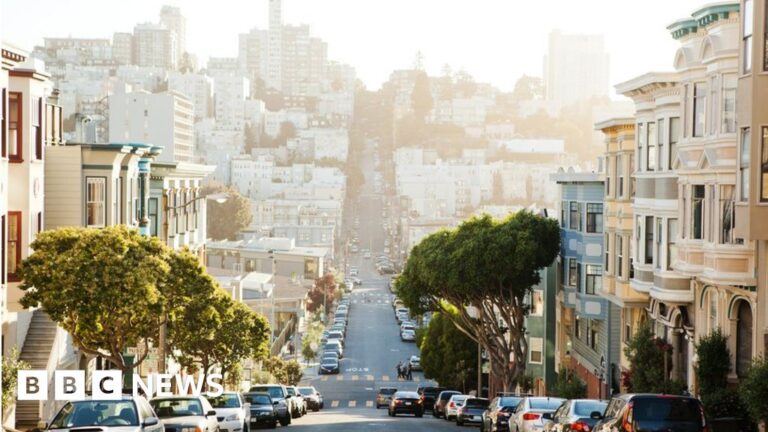- Ryan Nunn and Jay Shambaugh
- The Hamilton Project, Brookings Institution
Image source, Getty Images
According to government statistics, a family living in one US city on an annual income of $117,400 (£87,970) could now be considered “low-income”. How is this possible?
It may surprise many that workers earning six-figure salaries can be considered “poor.”
In San Francisco and the neighbouring counties of San Mateo and Marin, $117,400 for a family of four is considered “low income” and $73,300 (£54,900) is considered “very low income”, the highest figures in the country.
Looking at how incomes vary across the U.S. and among occupations sheds light on what's happening across cities and the country, a factor explored in a new study and interactive website by the Hamilton Project at the Brookings Institution.
Below the poverty line
Image source, Getty Images
Nearly two-thirds of American families of four live below San Francisco's “low-income” threshold of $117,400.
Across the US, the average (median) household income for a family of four is $91,000 (£68,170). Regardless of family size, the figure is $59,000 (£44,180). (For the purposes of this article, we use average income.)
And in a country of 326 million people, more than 40 million families of all sizes live below the poverty line, which is $25,100 (£18,800) for a family of four.
When we look at all the jobs, we find that some big cities pay much more than other parts of the country.
San Francisco is particularly notable.
The city has become a hub for IT and other high-tech industries, driving economic growth and becoming home to many of the country's highest-paid workers.
Between 2008 and 2016, personal income for full-time workers aged 25 to 64 in the San Francisco metropolitan area (which includes Alameda and Contra Costa counties) grew by 26%, a much higher increase than in many other metropolitan areas. By 2016 income had risen to $63,000 (£47,200).
Of course, there are other parts of the United States where wages are higher.
The typical income for a full-time worker aged 25 to 64 in recent years was $65,000 (£48,670) in San Jose, $60,600 (£45,400) in Washington DC and $55,700 (£41,700) in Boston.
There are plenty of high-paying jobs in these high-paying locations.
In San Francisco, a doctor, the highest paying profession, can expect to earn $193,400 (£144,800) a year, a typical CEO or government official can expect to earn $167,300 (£125,260) and a software developer can expect to earn $117,100 (£87,670).
But there are many who earn much less than that.
San Francisco's lowest paid workers are agricultural workers, with an average annual salary of $18,500 (£13,850), and childcare workers, earning $22,300 (£16,700).
Wages in other major U.S. cities are significantly lower.
In Detroit, for example, doctors earn an average of $144,300 (£108,000) a year, while childcare workers earn just $15,000 (£11,230).
But wide variance in revenues is only part of the equation.
The cost of living, especially housing, plays a key role in determining how far workers can stretch their income.
In fact, the overall cost of living in the San Francisco area is 25% higher than the national average.
But with incomes 45% higher than the national average, many San Francisco residents are still ahead.
Looking specifically at housing costs, the comparison is unfavorable.
In many big cities, the problem of rising rents and home prices is exacerbated by strict building regulations and widening income inequality.
The decision to classify some families with six-figure incomes as “low-income” is driven by high rent prices in San Francisco.
For example, fair market rent for a two-bedroom apartment in the San Francisco area is listed as $3,121 (£2,340) a month, almost double the $1,592 (£1,190) in 2008. In Cincinnati, Ohio, the figure is $845 (£632) – a difference (270%) far greater than the difference in median household income (50%).
Image source, Getty Images
That makes housing affordability a big challenge for many people in San Francisco.
The U.S. government typically defines a low-income household as one that makes less than 80% of the median income for households of the same size living in the same area.
But in areas where housing costs are unusually high, the threshold can be even higher.
In San Francisco, rising rents have pushed the government's “low-income” threshold of $117,400 (£87,970) to almost the same level as the area's median income for a family of four, $118,400 (£88,630).
Falling below this threshold does not automatically mean you will be eligible for government housing assistance such as subsidies or public housing, but it is a factor to be taken into consideration.
Something More Important Than Money
But, of course, it is worth considering that for many people, higher prices are something they can put up with in order to enjoy a higher quality of life.
San Francisco is certainly an expensive place to live, but its great weather and rich cultural life attract many residents.
Across the US, cities rated as having the highest quality of life, such as San Francisco and Santa Barbara in California and Honolulu in Hawaii, often tend to have the highest costs of living.
Families with six-figure incomes may not be considered “low-income” in the broader sense, but figuring out how to provide a quality of life for all of their residents remains a challenge for expensive cities across the US.
A critical look at how we can provide more affordable housing would be a logical first step.
The Brookings Institution is a nonprofit public policy institute that conducts research that leads to new ideas for solving problems facing society.


